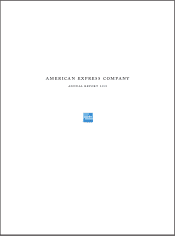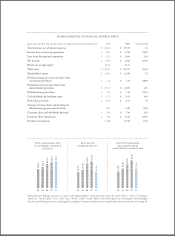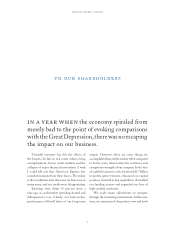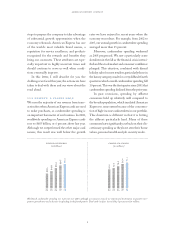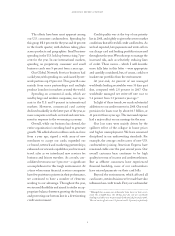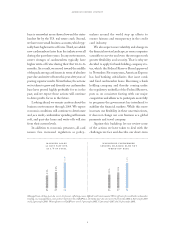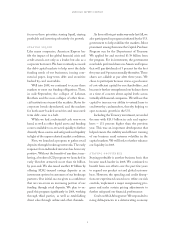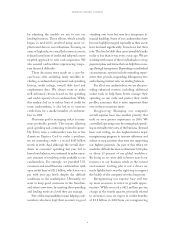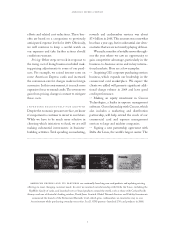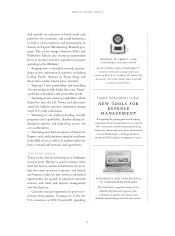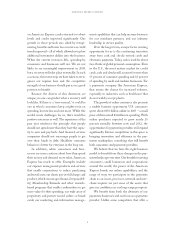American Express 2008 Annual Report Download - page 6
Download and view the complete annual report
Please find page 6 of the 2008 American Express annual report below. You can navigate through the pages in the report by either clicking on the pages listed below, or by using the keyword search tool below to find specific information within the annual report.
american express company
4
base is somewhat more skewed toward the states
hardest hit by the U.S. real estate crash. Second,
we have more small business accounts, which typ-
ically have higher write-off rates. Third, we added
new cardmembers faster than the industry overall
during the past three years. In any environment,
newer vintages of cardmembers typically have
higher write-off rates during their first 24-to-36
months. As a result, we moved toward the middle
of the pack among card issuers in terms of absolute
past-due and write-off rates this year after years of
posting superior results. Nevertheless, the actions
we’ve taken to grow and diversify our cardmember
base have proved highly profitable for us in the
past, and we expect those actions will continue
to drive profits for us in the future.
Looking ahead, we remain cautious about the
business environment through 2009. We expect
economic conditions will continue to deteriorate
and, as a result, cardmember spending will remain
soft, and past-due loans and write-offs will rise
from their current levels.
In addition to economic pressures, all card
issuers face increased regulation as policy-
makers around the world step up efforts to
ensure fairness and transparency in the credit
card industry.
We also expect more volatility and change in
the financial services landscape, as some companies
scramble to survive and even the strongest seek
greater flexibility and security. That is why we
decided to apply for bank holding company sta-
tus, which the Federal Reserve Board approved
in November. For many years, American Express
has had banking subsidiaries that issue cards
and fund cardmember loans. Becoming a bank
holding company, and thereby coming under
the regulatory umbrella of the Federal Reserve,
puts us on consistent footing with our major
competitors and allows us to participate more fully
in programs the government has introduced to
stabilize the financial markets. While this move
increases our flexibility in these uncertain times,
it does not change our core business as a global
payments and travel company.
Against this backdrop, let me review some
of the actions we have taken to deal with the
challenges we face and describe our short-term
Managed loans 30 days past due rose to 4.6 percent, reflecting a more difficult credit environment. Write-off rates for worldwide cardmember
lending, on a managed basis, increased to 5.4 percent. On a GAAP basis, the 30 day past-due rates were 4.4 percent for 2008, 2.8 percent for 2007
and 2.2 percent for 2006. Write-off rates on a GAAP basis were 5.5 percent for 2008, 3.5 percent for 2007 and 3.3 percent for 2006.
managed loans
30 days past due
as a % of total
08
4.6%
2.8%
07
wor ldwide cardmember
lending managed basis net
write-off rate
08
5.4%
3.3%
07
2.9%
06
2.3%
06

